Murray State University
Las últimas cargas en Murray State University. ¿Buscando notas en Murray State University? Tenemos muchas notas, guias de estudio y notas de estudio disponsible para tu escuela.
-
199
- 0
-
18
All courses for Murray State University
-
ACC200 ACC200 31
-
Astronomy 1
-
Basic Life Support NURSING 412 1
-
ENG105 ENG105 1
-
Honors Seminar in World History 1 HON201 2
-
NUR 205 NUR205 2
-
NUR 412 1
-
NUR205 1
-
NURSING 319 NURSING 319 1
-
POL140 POL140 9
Últimos notas y resúmenes Murray State University
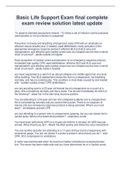
Basic Life Support Exam final complete exam review solution latest update To observe standard precautions means: Prevention of airway and breathing emergencies; early CPR with an emphasis on effective rescue breaths and, if needed, rapid defibrillation; early activation of the appropriate emergency response protocol; effective BLS and ALS care and transportation; and effective post-cardiac arrest care at a hospital are the links in which chain of survival? Early recognition of cardia...
- Package deal
- Examen
- • 3 páginas's •
-
Murray State University•Basic Life Support
-
BASIC LIFE SUPPORT Exam A ACLS VERSIONS COMPLETE TEST QUESTIONS AND ANSWERS• Porsmartzone
Vista previa 1 fuera de 3 páginas
Basic Life Support Exam final complete exam review solution latest update To observe standard precautions means: Prevention of airway and breathing emergencies; early CPR with an emphasis on effective rescue breaths and, if needed, rapid defibrillation; early activation of the appropriate emergency response protocol; effective BLS and ALS care and transportation; and effective post-cardiac arrest care at a hospital are the links in which chain of survival? Early recognition of cardia...
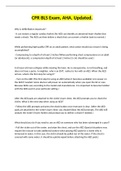
CPR BLS Exam, AHA. Updated.
- Package deal
- Examen
- • 5 páginas's •
-
Murray State University•CPR BLS AHA
-
AHA BLS certification Exams Solution Guide package• PorSmartShirley
Vista previa 2 fuera de 5 páginas
CPR BLS Exam, AHA. Updated.
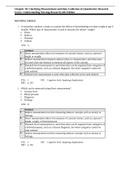
Chapter 10: Clarifying Measurement and Data Collection in Quantitative Research Grove: Understanding Nursing Research, 6th Edition MULTIPLE CHOICE 1. A researcher conducts a study to examine the effects of breastfeeding on infant weight at age 6 months. Which type of measurement is used to measure the infants’ weight? a. Direct b. Indirect c. Nominal d. Ordinal ANS: A Feedback A Direct measurement allows for measures of concrete factors, such as a person’s height or weight. B In...
- Examen
- • 19 páginas's •
-
Murray State University•NUR 306
Vista previa 3 fuera de 19 páginas
Chapter 10: Clarifying Measurement and Data Collection in Quantitative Research Grove: Understanding Nursing Research, 6th Edition MULTIPLE CHOICE 1. A researcher conducts a study to examine the effects of breastfeeding on infant weight at age 6 months. Which type of measurement is used to measure the infants’ weight? a. Direct b. Indirect c. Nominal d. Ordinal ANS: A Feedback A Direct measurement allows for measures of concrete factors, such as a person’s height or weight. B In...

A researcher conducts a study to examine the effects of breastfeeding on infant weight at age 6 months. Which type of measurement is used to measure the infants’ weight? a. Direct b. Indirect c. Nominal d. Ordinal ANS: A Feedback A Direct measurement allows for measures of concrete factors, such as a person’s height or weight. B Indirect measurement measures abstract ideas or characteristics and often must use more than one measure to measure all aspects of the concept. C Nominal...
- Package deal
- Examen
- • 19 páginas's •
-
Murray State University•NUR 306
-
Wagner College NR 400 Test Prepschaper 1_ 6 A Guides Latest 2022-2023.• Porgreatsolutions
Vista previa 3 fuera de 19 páginas
A researcher conducts a study to examine the effects of breastfeeding on infant weight at age 6 months. Which type of measurement is used to measure the infants’ weight? a. Direct b. Indirect c. Nominal d. Ordinal ANS: A Feedback A Direct measurement allows for measures of concrete factors, such as a person’s height or weight. B Indirect measurement measures abstract ideas or characteristics and often must use more than one measure to measure all aspects of the concept. C Nominal...
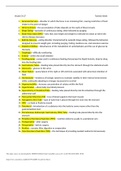
Vocab Ch 27 Tamela Street 1. Anorexia Nervosa—disorder in which the focus is on remaining thin, causing restriction of food intake to the point of danger 2. Atherosclerosis—the accumulation of fatty deposits on the walls of blood vessels 3. Binge Eating—episodes of continuous eating, often followed by purging 4. Body Mass Index (BMI)—ratio that uses height and weight to estimate fat values at which the risk for disease increases 5. Bulimia Nervosa—eating disorder characterized b...
- Examen
- • 1 páginas's •
-
Murray State University•NUR MISC
Vista previa 1 fuera de 1 páginas
Vocab Ch 27 Tamela Street 1. Anorexia Nervosa—disorder in which the focus is on remaining thin, causing restriction of food intake to the point of danger 2. Atherosclerosis—the accumulation of fatty deposits on the walls of blood vessels 3. Binge Eating—episodes of continuous eating, often followed by purging 4. Body Mass Index (BMI)—ratio that uses height and weight to estimate fat values at which the risk for disease increases 5. Bulimia Nervosa—eating disorder characterized b...
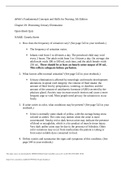
1. How does the frequency of urination vary? (See page 543 in your textbook.) The frequency of urination varies. Infants void from 5 to 40 times a day. The preschool child may void every 2 hours. The adult voids from 5 to 10 times a day. On average, the adult male voids 300 to 500 mL each time, and the adult female voids 250 mL. There should be at least an hourly urine output of 30 mL. This reflects adequate kidney perfusion. 2. What factors affect normal urination? (See page 543 ...
- Examen
- • 4 páginas's •
-
Murray State University•NUR MISC
Vista previa 1 fuera de 4 páginas
1. How does the frequency of urination vary? (See page 543 in your textbook.) The frequency of urination varies. Infants void from 5 to 40 times a day. The preschool child may void every 2 hours. The adult voids from 5 to 10 times a day. On average, the adult male voids 300 to 500 mL each time, and the adult female voids 250 mL. There should be at least an hourly urine output of 30 mL. This reflects adequate kidney perfusion. 2. What factors affect normal urination? (See page 543 ...
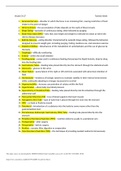
Vocab Ch 27 Tamela Street 1. Anorexia Nervosa—disorder in which the focus is on remaining thin, causing restriction of food intake to the point of danger 2. Atherosclerosis—the accumulation of fatty deposits on the walls of blood vessels 3. Binge Eating—episodes of continuous eating, often followed by purging 4. Body M
- Examen
- • 1 páginas's •
-
Murray State University•NUR MISC
Vista previa 1 fuera de 1 páginas
Vocab Ch 27 Tamela Street 1. Anorexia Nervosa—disorder in which the focus is on remaining thin, causing restriction of food intake to the point of danger 2. Atherosclerosis—the accumulation of fatty deposits on the walls of blood vessels 3. Binge Eating—episodes of continuous eating, often followed by purging 4. Body M
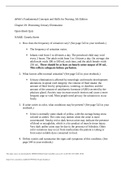
Open-Book Quiz NAME: Tamela Street 1. How does the frequency of urination vary? (See page 543 in your textbook.) The frequency of urination varies. Infants void from 5 to 40 times a day. The preschool child may void every 2 hours. The adult voids from 5 to 10 times a day. On average, the adult male voids 300 to 500 mL each time, and the adult female voids 250 mL. There should be at least an hourly urine output of 30 mL. This reflects adequate kidney perfusion. 2. What factors af...
- Examen
- • 4 páginas's •
-
Murray State University•NUR MISC
Vista previa 1 fuera de 4 páginas
Open-Book Quiz NAME: Tamela Street 1. How does the frequency of urination vary? (See page 543 in your textbook.) The frequency of urination varies. Infants void from 5 to 40 times a day. The preschool child may void every 2 hours. The adult voids from 5 to 10 times a day. On average, the adult male voids 300 to 500 mL each time, and the adult female voids 250 mL. There should be at least an hourly urine output of 30 mL. This reflects adequate kidney perfusion. 2. What factors af...
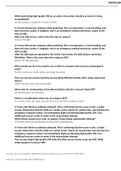
Basic Life Support Exam B_ complete questions and answers Updated 2022. VERIFIED While performing high-quality CPR on an adult, what action should you ensure is being accomplished? Compressing to a depth of at least 2 inches A 53-year-old woman collapses while gardening. She is unresponsive, is not breathing, and does not have a pulse. A neighbor, who is an emergency medical technician, rushes to her with an AED. When the AED arrives, what is the first step for using it? Turn on the AED ...
- Examen
- • 3 páginas's •
-
Murray State University•Basic Life Support
Vista previa 1 fuera de 3 páginas
Basic Life Support Exam B_ complete questions and answers Updated 2022. VERIFIED While performing high-quality CPR on an adult, what action should you ensure is being accomplished? Compressing to a depth of at least 2 inches A 53-year-old woman collapses while gardening. She is unresponsive, is not breathing, and does not have a pulse. A neighbor, who is an emergency medical technician, rushes to her with an AED. When the AED arrives, what is the first step for using it? Turn on the AED ...
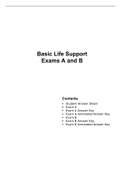
1. While performing high-quality CPR on an adult, what action should you ensure is being accomplished? A. Maintaining a compression rate of 90 to 120/min B. Placing hands on the upper third of the sternum C. Allowing the chest to recoil 1 inch D. Compressing to a depth of at least 2 inches Use this scenario to answer the next 2 questions: A 53-year-old woman collapses while gardening. She is unresponsive, is not breathing, and does not have a pulse. A neighbor, who is an emergency medi...
- Examen
- • 40 páginas's •
-
Murray State University•BLS
Vista previa 4 fuera de 40 páginas
1. While performing high-quality CPR on an adult, what action should you ensure is being accomplished? A. Maintaining a compression rate of 90 to 120/min B. Placing hands on the upper third of the sternum C. Allowing the chest to recoil 1 inch D. Compressing to a depth of at least 2 inches Use this scenario to answer the next 2 questions: A 53-year-old woman collapses while gardening. She is unresponsive, is not breathing, and does not have a pulse. A neighbor, who is an emergency medi...
